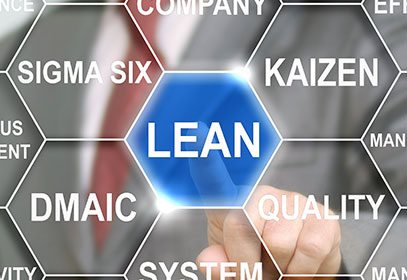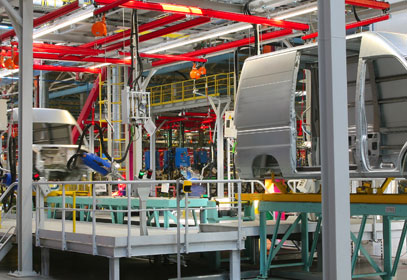Resources
Continuous Improvement Articles
DMAIC for Problem-Solving
DMAIC, is a data driven problem solving strategy employed by manufacturing businesses. To maximize productivity, learn more about this solution oriented strategy. …
Understanding Total Quality Management
Learn about the transformative power of Total Quality Management (TQM) and how it can drive long-term success, customer satisfaction, & operational excellence. …
What is Lean in Business?
Lean in business means getting the most value while wasting as little as possible and finding ways to improve processes throughout the entire value chain. …
Lean in Different Industries
The Lean methodology originated in the manufacturing sector, buit its core principles of continuous improvement, process optimization, and employee empowerment can be effectively applied across a wide range of industries. …
Heijunka (Production Leveling)
Heijunka is a Japanese word that means leveling. It consists of a lean manufacturing tool that helps companies level production and thus satisfy demand and reduce waste. …
Control Charts: A Basic Component of Six Sigma
Statistical process control charts are a helpful visualization tool for recognizing deviation within a process. These charts help operators know when to take action. …
John Krafcik and the Birth of the Term Lean
Learn all about where the term Lean came from in this article! You’ll read about John Krafcik and his initial studies on Lean production methods. …
William Edwards Deming: The Father of Quality Management
William Edwards Deming was incredibly influential in the world of quality management, and by extension, the development of Lean manufacturing. Learn about him here. …
Autonomous Maintenance: The Key to a Healthy TPM Program
Autonomous maintenance is an important part of Total Productive Maintenance strategies. This is done by handing over simple maintenance tasks to machine operators. …
A Look at Training Within Industry (TWI)
Training within Industry, or TWI, uses a series of training modules to develop leaders within a business that then train new employees quickly and effectively. …
Understanding the Principles of Lean Construction
When Lean techniques are incorporated into traditional methods of construction, a project is completed more efficiently. These are the main principles behind Lean Construction. …
Understanding the SIPOC Diagram in Six Sigma
Creating a SIPOC diagram to determine the Suppliers, Inputs, Process, Outputs, and Customers of an operation can help businesses achieve improvement and ensure Six Sigma success. …
Understanding Design for Six Sigma (DFSS)
DFSS is an improvement technique that uses the DMADV approach to ensure that a product or service meets customer expectations as it is originally introduced to the market. …
Supply Chain Management (SCM)
A smooth and efficient supply chain ensures quality products, customer satisfaction, and a positive reputation. These are the essential components to effective supply chain management. …
6S: Safety
Safety is the additional sixth step to the traditional 5S method. A company that implements 6S focuses on improving organization and efficiency, with an emphasis on safety throughout each step. …
Quality Control
Quality Control helps ensure products are meeting customer needs and reduce the risk of product defects. Let this article help get you started. …
Kaizen and Lean Manufacturing
Going “Lean” is all about continuous improvement. Kaizen gives Lean manufacturers the tools and strategies they need to identify wastes in their facility and effectively eliminate them. …
A Brief History of Kaizen: The Key Players
Kaizen has been shaped over the years by an automobile manufacturer, American statisticians, influential businessmen, and more. We explore who had a hand in creating Kaizen and how it has developed into the philosophy we know today. …
An In-Depth History of the Kaizen PDCA Cycle
Lean organizations focus on improving all parts of a process from start to finish in order to increase the quality of the results. Through the use of specific cycles (like PDCA), organizations can improve the processes and end products. …
Quality Management Systems (ISO 9001:2015)
ISO 9001: 2015 is a standard that outlines and defines requirements for a quality management systems. This QMS certification allows companies to demonstrate to clients that they take quality and efficiency seriously. …
DMAIC Cycle
The DMAIC cycle is the foundational method of Six Sigma, the Lean manufacturing method that radically reduces defects in production and infinitely improves efficiency. Learn how to implement Six Sigma into your facility with DMAIC. …
Statistical Process Control (SPC) in Manufacturing
Statistical Process Control also known as SPC, is a term used in quality control. Find out how you can use this continuous improvement method. …
5 Lean Principles for Process Improvement
Learning the basics about the lean process is essential when implementing continuous improvement changes. We have broken down the lean process so its easy to understand. …
Continuous Improvement (A Kaizen Model)
Facilities that focus on continuous improvement become more competitive over time and can maintain their advantages in their industry, but only if the improvement efforts are done correctly. …
Getting Started with Kaizen
Proper training is key for getting started with Kaizen and on the road to continuous improvement. …
Continuous Improvement Questions and Answers
What does Quality really mean?
Quality can be defined as a desirable trait or characteristic of something or someone. When used as an adjective, it refers to something that is of high standard or excellence. It can be applied to various aspects of life, including goods, services, education, healthcare, and more. Ultimately, quality refers to meeting or exceeding expectations and… …
How does critical thinking relate to skill development?
Critical thinking is the ability to actively and skillfully analyze and evaluate information, and use that analysis to guide decision making and problem solving. Developing this skill requires ongoing practice and learning, including building knowledge in specific areas, improving communication skills, recognizing personal biases, and engaging in regular reflection and self-evaluation. Resources such as books,… …
What is Socratic Questioning?
Socratic questioning is a form of inquiry-based dialogue that encourages critical thinking and self-reflection by asking probing questions to explore the assumptions, evidence, and implications of an idea. In education, Socratic questioning can be used to help students analyze concepts, differentiate between systematic and fragmented thinking, and become independent learners. In psychotherapy, Socratic questioning can… …
How has Continuous Improvement helped businesses?
The continuous improvement philosophy is becoming more and more popular among organizations who are seeing the potential to enhance efficiency and reduce waste. For those who are keen to try it out for themselves but don’t know where to begin or how to apply it to their industry, we have pulled together a range of… …
What is Continuous Improvement?
Continuous Improvement, often referred to as CI, is a foundational philosophy that has reshaped the way organizations operate, innovate, and thrive in today's dynamic business landscape. At its core, Continuous Improvement is not just a methodology; it's a mindset and a way of approaching work that prioritizes growth, efficiency, and innovation. Continuous Improvement is also… …
How is Continuous Improvement related to Kaizen?
Continuous Improvement and Kaizen are two concepts that share common goals and principles, yet they have distinct approaches and applications. Both are integral to fostering growth, innovation, and efficiency within organizations. In this article, we will explore the relationship between Continuous Improvement and Kaizen, shedding light on their similarities, differences, and the impact they have… …
What are Continuous Improvement methodologies?
In the pursuit of organizational excellence, businesses are increasingly turning to Continuous Improvement methodologies to drive efficiency, enhance processes, and foster innovation. These structured approaches, typically overseen by a Continuous Improvement Engineer or Manager, provide a systematic framework for identifying opportunities, implementing changes, and achieving incremental advancements. Let's delve into the world of Continuous Improvement… …
What is a Continuous Improvement Engineer?
In the world of modern business, staying competitive requires more than just maintaining the status quo. Continuous improvement has emerged as a fundamental strategy for organizations to enhance processes, drive efficiency, and innovate. For example, Continuous Improvement can be used in a variety of industries such as It, Retail, Healthcare, and even Education. At the… …
What are some examples of Continuous Improvements?
In the quest for operational excellence, organizations often choose to embark on a journey of continuous improvement. This journey is marked by incremental enhancements and evolving strategies. Activities related to continuous improvement are usually facilitated by a CI manager and carried out by a CI Engineer. Let's delve into some tangible examples that showcase the… …
What is the Continuous Improvement Process?
In a world where businesses strive for excellence, the continuous improvement process emerges as a guiding principle. It's a dynamic approach that empowers organizations to evolve, adapt, and enhance their operations over time. Let's explore the continuous improvement process and uncover how it contributes to sustained success. Defining Continuous Improvement Process At its core, the continuous improvement… …
What is the DMAIC Cycle? A Comprehensive Guide
In the realm of process improvement and quality management, the DMAIC cycle stands as a cornerstone methodology. DMAIC, an acronym for Define, Measure, Analyze, Improve, and Control, is a structured approach used to solve complex problems and enhance processes. In many facilities, a Continuous Improvement Manager orchestrates these activities, but it can really be done… …
What is a Continuous Improvement Manager?
In the landscape of modern business, the role of a Continuous Improvement Manager stands out as a pivotal one, focused on driving organizational excellence through systematic enhancements. Let's delve into the responsibilities, skills, and significance of this role in fostering a culture of continuous improvement. Role and Responsibilities A Continuous Improvement Manager is entrusted with the critical… …
How do Continuous Improvement and Lean Increase Efficiency?
In the pursuit of operational excellence, organizations often turn to methodologies like Continuous Improvement and Lean to enhance efficiency, reduce waste, foster innovation, and even drive sustainable growth. Let's explore how these two concepts work hand in hand to streamline processes and optimize performance. Continuous Improvement: A Path to Perfection Continuous Improvement, also known as Kaizen, is… …
What does Continuous Improvement and Innovation mean?
In today's rapidly evolving business landscape, staying ahead requires more than just a static approach. Continuous improvement and innovation have become fundamental concepts that drive the success of organizations across industries. Let's delve into what these terms entail and how they contribute to the growth and sustainability of businesses. Continuous Improvement: Enhancing what’s already there Continuous improvement,… …
What is Earned Value Management (EVM)?
Earned value management, or EVM, is a type of project management that is used for measuring the performance and progress of a project in an objective manner. By looking at the scope, time, and costs of a project this system is able to properly evaluate the value of the work being done. One of the main concepts… …
What does PDCA stand for?
PDCA stands for Plan-Do-Check-Act. It is a strategy used for continuous improvement in the workplace (or any other environment). It was popularized by W. Edwards Deming who helped to push forward modern quality improvement and quality control strategies. In many ways, PDCA emulates the well-known scientific method, and has been proven to be effective for… …


































